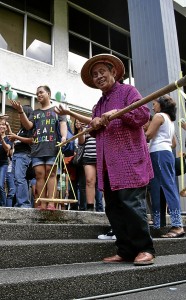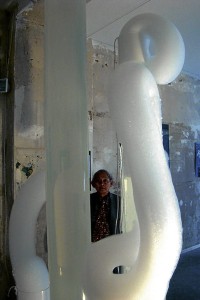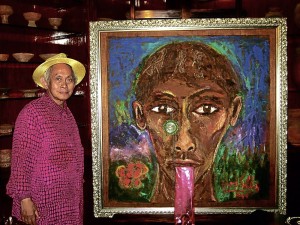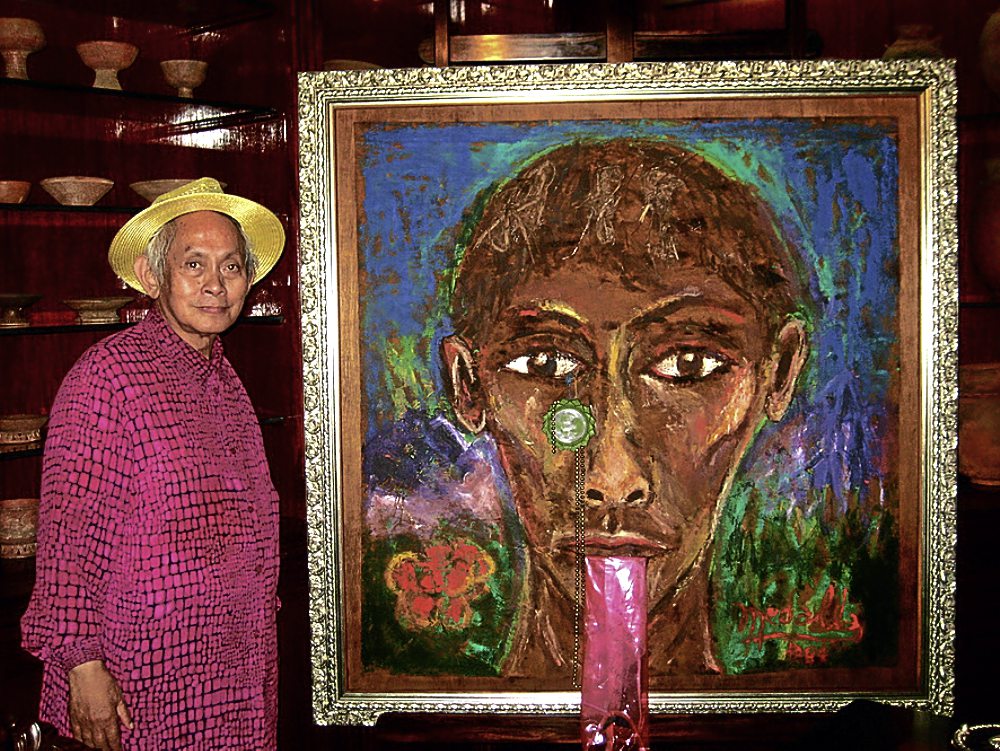
London-based Filipino artist David Cortez Medalla returns home after years of exploration, expansion, and establishment on the international art scene.
Considered an important figure in the history of art as a pioneer of kinetic, earth, performance, participation and conceptual art, Medalla comes back to the Philippines to celebrate his contributions and accomplishments as a Filipino artist.
His most iconic body of work, the “kinetic sculptures,” is best exemplified by his “Bubble Machines” of 1963 which, through the use of soap and water mixed with air funneled through an engine he especially designed, produced columns of froth that subverted the solid nature of sculpture, showing how it could be both static and dynamic.
“Disput[ing] the parameters of what constitutes sculpture. In choosing a medium that self-destructs as it is created, the stability of the work is undermined, the validity of the concepts of solidity and permanence in sculpture are brought into question,” Richard Dyer said in a 1995 issue of the influential Frieze magazine.
Medalla’s other kinetic sculptures were the “Sand Machine” (1964) and the “Mud Machine” (1964-1967).
At age 12, Medalla translated works of Blake, Shakespeare and Whitman into Filipino and lectured at University of the Philippines. At 14, he attended Columbia University on a scholarship to study philosophy and Greek drama.
In 1955, he founded the Poetry Club of Manila and attended the art appreciation classes of Fernando Zobel at Ateneo de Manila University on Padre Faura. It was during this time that he began creating semi-figurative mixed-media work that would eventually form part of the original collection of Ateneo Art Gallery. Among these were “The Joyous Kingdom” and “My Sister at the Sewing Machine” (both 1956).
Avante-garde icons
Medalla first held his one-man show in a hole-in-the-wall space on Mabini Street in Malate, which he called “La Cave d’Angely.” He was the youngest artist to be selected in a survey of Philippine art, organized by the Unesco in the Social Hall of the Department of Foreign Affairs.

He left Manila in 1959 and traveled by ship to Europe, passing through Singapore, Indochina, Sri Lanka, India, Pakistan, East Africa and Egypt, before landing in Marseilles.
In Paris in 1969, Medalla performed at the Akademia, the school founded by the poet, artist and dancer Raymond Duncan, where he was introduced by philosopher Gaston Bachelard. French poet Louis Aragon, co-founder of the Surrealist movement with André Breton, also introduced another performance of him. Conceptual artist Marcel Duchamp even created an artwork in honor of Medalla.
Settling in London, Medalla established the Centre for Advanced Creative Study (later renamed Signals London), a space dedicated to experiments in art and science, together with other artists. The center published Signals Newsbulletin which was edited by Medalla. Today, it is recognized by the Arts Council of England as an important record of the avant-garde art movement of that time.
Also during this time, Medalla developed arguably his most iconic body of work—the kinetic sculptures.
Moving into a new genre known as participatory art, his work during this stage include “A Stitch in Time” (1967/1968), in which the audience was invited to be involved in the process of creation by sewing messages onto a sheet of cloth.
Art activist
Medalla did not only immerse himself in the arts but also in social, cultural and gender issues. He founded the Exploding Galaxies, an organization of multimedia artists working around those themes. He also established Artists for Democracy.
During the inauguration of the Cultural Center of the Philippines in 1969, Medalla, together with the artists Marciano Galang and the poet Jun Lansang, unfurled a banner that read “A bas la mystification [down with pretense], down with philistines!” from a balcony overlooking the lobby of the Cultural Center of the Philippines. The inauguration was attended by President Ferdinand Marcos and First Lady Imelda Marcos accompanied by then Gov. Ronald Reagan and Mrs. Reagan.

In the ’70s, Medalla was included by Harold Szeeman in the fifth staging of “Documenta,” arguably the world’s most prestigious exhibition of international contemporary art.
Together with artist Adam Nankervis, who has remained his staunchest collaborator, Medalla founded the Mondrian Fan Club in 1991, which they dedicated to celebrating the legacy of the late Dutch geometric abstract artist through exhibitions and performances, and an ongoing series of ephemeral artworks in different parts of the globe titled “Cosmic Graffiti.”
While participating in the 1997 Johannesburg Biennial, the two took a boat trip to Robben Island, where Nelson Mandela had been held in captivity. This ignited Medalla to eventually establish the first London Biennial in 2000.
Staged every two years, the biennial has become a platform for artists like Mai Ghoussoub, Mark McGowan, Deej Fabyc, Marko Stepanov, Adam Nankervis, James Moores, Dimitri Launder, Fritz Stolberg, Salih Kayra, Marisol Cavia, and many others.
Medalla is the only Filipino to be included in the permanent collection of one of the world’s greatest museums, the Tate, where he is exhibiting alongside Hans Holbein, Anthony Van Dyck, Piet Mondrian and Pablo Picasso.
In 2011, his “Cloud Canyons” No. 14, an iteration of Bubble Machines was unveiled at the New Museum in New York as “an iconic work of 20th-century art.”
On Nov. 27, Medalla will be coming back to his homeland to receive an award from his alma mater, Ateneo de Manila University. In a special academic convocation, he will be conferred the Gawad Tanglaw ng Lahi, which is given to those who have dedicated their life’s work to the pursuit of Filipinism and the Filipino identity through any of the channels of culture.
The opening of Medalla’s “Tuloy Po Kayo” exhibit at Ateneo Art Gallery follows immediately after the convocation on Nov. 27.









































